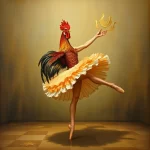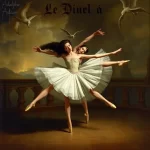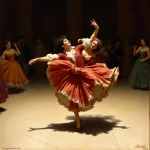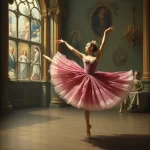Ballet: The Golden Cockerel (Nikolai Rimsky-Korsakov, 1914)

Introduction
Ballet, an art form that combines music, dance, and storytelling, has produced numerous masterpieces over the centuries. One such gem is “The Golden Cockerel,” a ballet composed by Nikolai Rimsky-Korsakov in 1914. This ballet, choreographed by Michel Fokine, premiered on May 21, 1914, at the Théâtre National de l’Opéra in Paris. “The Golden Cockerel” is a fantastical tale based on a poem by Alexander Pushkin, blending elements of Russian folklore and satire to create a captivating narrative.
Historical Background
Creation and Development
“The Golden Cockerel” was created during a period of significant artistic and social change in Russia. The early 20th century was marked by a burgeoning interest in Russian folklore and nationalism, which influenced many artists and composers. Rimsky-Korsakov, a prominent figure in Russian classical music, was inspired by Alexander Pushkin’s 1834 poem “The Tale of the Golden Cockerel.” This literary source provided a rich tapestry of characters and themes that Rimsky-Korsakov masterfully translated into a musical score.
The collaboration between Rimsky-Korsakov and choreographer Michel Fokine was crucial to the ballet’s development. Fokine, known for his innovative approach to ballet, sought to break away from traditional forms and create more expressive and dramatic works. Together, they crafted a ballet that was both visually and musically stunning, incorporating elements of Russian folklore, satire, and fantasy.
Premiere and Reception
“The Golden Cockerel” premiered on May 21, 1914, at the Théâtre National de l’Opéra in Paris. The initial reception was mixed, with some critics praising the ballet’s innovative choreography and enchanting music, while others found it too avant-garde. Despite the divided opinions, the ballet quickly gained popularity and became a staple in the repertoires of major ballet companies.
Notable early performances included productions by the Ballets Russes, a renowned ballet company founded by Sergei Diaghilev. These performances helped solidify “The Golden Cockerel” as a significant work in the world of ballet.
Synopsis of the Ballet
Act I Summary
The ballet opens with the introduction of King Dodon, a foolish and lazy ruler who is constantly worried about the safety of his kingdom. To ease his fears, he consults an astrologer, who presents him with a magical golden cockerel. The cockerel has the power to warn the king of any impending danger. Satisfied with this solution, King Dodon rewards the astrologer with a promise to grant him any wish he desires.
As the cockerel stands guard, King Dodon dreams of a peaceful and prosperous reign. However, his dreams are soon interrupted by the cockerel’s warning of an approaching enemy. The king hastily sends his sons to investigate, but they are both killed in battle. Distraught, King Dodon decides to lead his army himself.
Act II Summary
In the second act, King Dodon encounters the beautiful Queen of Shemakha, who has been causing the unrest in his kingdom. Enchanted by her beauty, the king falls in love and proposes marriage. The Queen, seeing an opportunity to manipulate the king, accepts his proposal but demands that he perform a series of humiliating tasks to prove his love.
As King Dodon complies with the Queen’s demands, the astrologer reappears to claim his reward. He asks for the Queen of Shemakha, but the king, blinded by love, refuses. In a fit of rage, the astrologer reveals the true nature of the golden cockerel and its connection to the Queen’s schemes.
Finale
The ballet concludes with a dramatic confrontation between King Dodon, the Queen of Shemakha, and the astrologer. The golden cockerel, now revealed as a symbol of the king’s folly and arrogance, attacks and kills King Dodon. The Queen and the astrologer disappear, leaving the kingdom in chaos. The ballet ends with a somber reflection on the consequences of greed and vanity.
Musical Composition
Composer’s Role
Nikolai Rimsky-Korsakov, a master of orchestration and a key figure in Russian classical music, composed the score for “The Golden Cockerel.” His music is characterized by its rich harmonies, vibrant orchestration, and incorporation of Russian folk melodies. Rimsky-Korsakov’s contribution to the ballet is significant, as his score enhances the narrative and brings the fantastical elements of the story to life.
Musical Themes and Motifs
The score of “The Golden Cockerel” features several recurring musical themes and leitmotifs that represent different characters and emotions. For example, the theme associated with the golden cockerel is sharp and piercing, reflecting its role as a harbinger of danger. In contrast, the music for the Queen of Shemakha is sensual and exotic, highlighting her allure and manipulative nature.
Rimsky-Korsakov’s use of these musical motifs helps to create a cohesive and immersive experience for the audience, as the music seamlessly transitions between scenes and emotions.
Famous Recordings and Performances
Over the years, there have been numerous recordings and performances of “The Golden Cockerel” that have garnered acclaim. Notable recordings include those conducted by Valery Gergiev with the Mariinsky Theatre Orchestra and by Neeme Järvi with the Gothenburg Symphony Orchestra. These recordings capture the brilliance of Rimsky-Korsakov’s score and have helped to keep the ballet’s music alive for contemporary audiences.
Choreography and Dance
Choreographer’s Vision
Michel Fokine, the choreographer of “The Golden Cockerel,” was known for his innovative approach to ballet. He sought to break away from the rigid structures of classical ballet and create more expressive and dramatic works. Fokine’s vision for “The Golden Cockerel” was to blend elements of Russian folklore with modern dance techniques, resulting in a ballet that was both visually stunning and emotionally engaging.
Signature Dance Numbers
One of the most iconic dance numbers in “The Golden Cockerel” is the Pas de Deux between King Dodon and the Queen of Shemakha. This dance showcases the Queen’s seductive and manipulative nature, as she entices the king with her graceful and alluring movements. Another notable scene is the Dance of the Golden Cockerel, where the cockerel’s sharp and precise movements reflect its role as a symbol of danger and warning.
Notable Interpretations
Over the years, different productions of “The Golden Cockerel” have interpreted the choreography in various ways. Some have emphasized the satirical elements of the story, while others have focused on the fantastical and folkloric aspects. Notable interpretations include productions by the Bolshoi Ballet and the Mariinsky Ballet, both of which have brought their unique styles and perspectives to the ballet.
Characters and Roles
Main Characters
- King Dodon: A foolish and lazy ruler who is easily manipulated by those around him. His vanity and greed ultimately lead to his downfall.
- Queen of Shemakha: A beautiful and cunning queen who uses her charm to manipulate King Dodon and achieve her own ends.
- The Astrologer: A mysterious figure who provides King Dodon with the golden cockerel and later reveals its true nature.
- The Golden Cockerel: A magical bird that serves as a symbol of danger and warning, ultimately leading to King Dodon’s demise.
Supporting Characters
- King Dodon’s Sons: Two princes who are sent to investigate the threat to the kingdom but are killed in battle.
- Court Officials and Soldiers: Various members of King Dodon’s court and army who play supporting roles in the story.
Famous Dancers
Over the years, many renowned dancers have portrayed the roles in “The Golden Cockerel.” Notable performers include Vaslav Nijinsky, who played the role of the Golden Cockerel in the original Ballets Russes production, and Anna Pavlova, who brought her grace and elegance to the role of the Queen of Shemakha.
Cultural and Artistic Impact
Influence on Ballet and Dance
“The Golden Cockerel” has had a significant influence on the world of ballet and dance. Its innovative choreography and integration of Russian folklore have inspired many choreographers and dancers. The ballet’s success also helped to solidify Rimsky-Korsakov’s reputation as a master composer and contributed to the development of ballet as an art form.
Cultural Significance
The ballet’s themes of vanity, greed, and the consequences of foolishness have resonated with audiences for over a century. “The Golden Cockerel” has also found its place in popular culture, with references in literature, theater, and other media. Its rich narrative and captivating music continue to inspire adaptations and reinterpretations in various art forms.
Legacy and Revivals
“The Golden Cockerel” has seen numerous revivals and reinterpretations over the years. Major ballet companies such as the Bolshoi Ballet and the Mariinsky Ballet have staged productions that bring new life to the classic tale. Contemporary choreographers have also explored modern adaptations, ensuring that the ballet remains relevant and celebrated today.
Iconic Productions
Historic Productions
One of the most famous historical productions of “The Golden Cockerel” was staged by the Ballets Russes in 1914. This production featured the legendary dancer Vaslav Nijinsky and was directed by Sergei Diaghilev. The set and costume designs by Natalia Goncharova added to the visual splendor of the ballet, making it a landmark production in the history of ballet.
Contemporary Productions
Recent productions of “The Golden Cockerel” have brought fresh perspectives to the ballet. For example, the Royal Ballet’s 2016 production, choreographed by Alexei Ratmansky, incorporated modern dance elements while staying true to the original story. These contemporary interpretations highlight the ballet’s enduring appeal and its ability to adapt to changing artistic trends.
Production Design
The set, costume, and lighting design play a crucial role in bringing “The Golden Cockerel” to life. Historical productions often featured elaborate and colorful designs that reflected the fantastical elements of the story. Contemporary productions have experimented with minimalist and abstract designs, focusing on the emotional and psychological aspects of the narrative. Regardless of the approach, the production design enhances the overall experience and helps to immerse the audience in the world of the ballet.
Critical Reception and Reviews
Initial Critical Response
At the time of its premiere, “The Golden Cockerel” received mixed reviews from critics. Some praised the ballet’s innovative choreography and enchanting music, while others found it too avant-garde and unconventional. Despite the divided opinions, the ballet quickly gained popularity and became a staple in the repertoires of major ballet companies.
Modern Reviews
Contemporary critics and audiences continue to appreciate “The Golden Cockerel” for its rich narrative, captivating music, and innovative choreography. Modern reviews often highlight the ballet’s timeless themes and its ability to resonate with audiences across different generations. The ballet’s enduring popularity is a testament to its significance in the world of dance.
Fun Facts and Trivia
Behind-the-Scenes Stories
One interesting anecdote from the original production of “The Golden Cockerel” involves Vaslav Nijinsky, who played the role of the Golden Cockerel. Nijinsky’s intense and precise movements were so convincing that some audience members believed he was actually a mechanical bird. This story highlights the level of dedication and skill that went into the performances.
Notable Performers
Over the years, many famous dancers, conductors, and directors have been associated with “The Golden Cockerel.” Notable performers include Anna Pavlova, who brought her grace and elegance to the role of the Queen of Shemakha, and Valery Gergiev, who conducted acclaimed recordings of the ballet’s music.
Trivia
- The original poem by Alexander Pushkin, “The Tale of the Golden Cockerel,” was inspired by a Spanish legend.
- “The Golden Cockerel” was Rimsky-Korsakov’s last opera before his death in 1908. The ballet adaptation was completed posthumously.
- The ballet’s themes of vanity and greed were seen as a subtle critique of the Russian monarchy and society at the time.
Conclusion
Summary of the Ballet’s Importance
“The Golden Cockerel” is a significant work in the world of ballet, combining rich narrative, captivating music, and innovative choreography. Its themes of vanity, greed, and the consequences of foolishness resonate with audiences across generations, making it a timeless masterpiece.
Final Thoughts
Reflecting on “The Golden Cockerel,” it is clear that this ballet has left an indelible mark on the world of dance. Its enduring popularity and continued relevance are a testament to the brilliance of Rimsky-Korsakov’s music and Fokine’s choreography. For those who have not yet experienced this enchanting ballet, it is highly recommended to watch a performance or listen to the score to fully appreciate its beauty and significance.
FAQ
What is the central theme of this ballet?
The central theme of “The Golden Cockerel” is the folly of vanity and greed, and the consequences of foolishness and arrogance.
Who are the main characters in this ballet?
The main characters are King Dodon, the Queen of Shemakha, the Astrologer, and the Golden Cockerel.
What is the most famous dance number in this ballet?
One of the most famous dance numbers is the Pas de Deux between King Dodon and the Queen of Shemakha, showcasing the Queen’s seductive and manipulative nature.
How long does a typical performance of this ballet last?
A typical performance of “The Golden Cockerel” lasts approximately 1.5 to 2 hours, including intermissions.
Are there any modern adaptations of this ballet?
Yes, there have been several modern adaptations of “The Golden Cockerel,” including contemporary productions that incorporate modern dance elements while staying true to the original story.
Why is this ballet considered important in the history of dance?
“The Golden Cockerel” is considered important in the history of dance due to its innovative choreography, captivating music, and its influence on subsequent works and choreographers. It represents a significant moment in the development of ballet as an expressive and dramatic art form.





